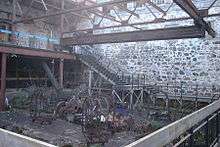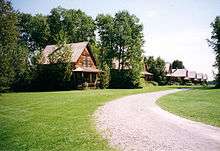Val-Jalbert


Val-Jalbert is a ghost town in the Saguenay-Lac-Saint-Jean region of Quebec, Canada. It is located 8 km northwest of the town of Chambord.
The village was founded in 1901 and soon saw success in the pulp mill created by Damase Jalbert at the base of the Ouiatchouan Falls. However, the success was fleeting as the abrupt closure of the mill in 1927 led the desertion of the entire village.
It became a park in 1960. With over 70 original abandoned buildings, Val-Jalbert has been described as the best-preserved ghost town in Canada.[1]
Toponymy
The village was founded by Damase Jalbert (1842-1904) which in 1901 also created the Ouiatchouan Pulp Company; that same year the village was first named Saint-Georges-de-Ouiatchouan, after the river that runs through it . It was later renamed Val-Jalbert in 1913 by the Chicoutimi Pulp Company in honor of its founder.
History
Company town
Located between the borders of the municipalities of Chambord and Roberval, Val-Jalbert was founded in 1901 when Damase Jalbert from Lac-Bouchette built a pulp and paper mill to meet growing demand for newsprint in Britain and America. The location was ideal since the energy required to operate the machinery could be produced by two waterfalls on the Ouiatchouan river, respectively 72 and 35 metres in height.
Following Jalbert's death in April 1904, the company was bought by American investors. The Ouiatchouan Falls Paper Company laid out the foundations of urban planning in the new community, with 4 types of dwellings for workers. The planned community separated workers housing located uptown, from the core business functions, located downhill. The company also built state of the art infrastructure in the remote community, including electricity, sewer, water works and telephone service.[2] [3]
The company was sold in 1909 to Julien-Édouard-Alfred Dubuc's Chicoutimi Pulp Company, who continued the planned development of the community.
Almost 10 years later, the Spanish Flu wreaked havoc among its small population.
Ghost town
In 1927, the Quebec Pulp and Paper Mills Ltd., which owned the plant for only a year, ceased all activities due to the lower demand for non-transformed mechanical pulp. Hoping for a reversal of the market, many unemployed workers remained in town until 1929, when the company ordered all homes boarded up. The local priest, Joseph-Edmond Tremblay, and the nuns from Chicoutimi who came to Val-Jalbert in 1915 to teach in the local school, definitively left the community on September 15, 1929.[3]
The company went bankrupt in 1949 and the Quebec government gained title on the land, buildings and the hydraulic forces of the former village.[4]
Tourist attraction
The site is first developed opened to the public in the 1960s by the Tourism office and was transferred to the parks agency SEPAQ with a view to develop the full potential of the village in 1987.[2]
In 1996, the Quebec Ministry of Culture and Communications designated the village as a heritage site and classify it as such.[2] The site now falls under the municipality of Chambord.
In the 2000s, the site controlled was transferred to the Domaine-du-Roy regional county municipality. The new administration applied and was granted a $17 million subsidy by the Quebec and federal governments in 2009 to overhaul the facilities in order to increase the annual patronage.[5]
The hydroelectric dam project on the Ouiatchouan river
In October 2009, the "Energy Community Society of Lac St-Jean" announced plans to build an 18.3 megawatt hydroelectric plant near the historic mill, and build a dam upstream of the Ouiatchouan falls. The “Bureau of Environmental Public Hearings” (BAPE) heard concerns of the citizens of Roberval and surrounding areas during the months of March and April 2012. 75% of the interventions submitted were against the dam project. Nevertheless, the BAPE gave a favourable report to the developer on July 13, 2012.
The historical village of Val-Jalbert is the second most visited tourist attraction in the Lac St-Jean region after the zoo of St-Félicien. The majority of tourists go to Val-Jalbert to see its spectacular waterfall. Meanwhile, the developer is moving forward with the project that promises to irrevocably distort the renowned waterfall, while promising a mere aesthetic flow of 7 m3 / s during daytime operational hours, which is half the average rate at which summer tourists are accustomed to. Even worse, at night and during the six winter months, the developer only ensures a mere ecological flow of 0.3 m3 / s, which is equivalent to a standard domestic hot water tank, which is hardly acceptable from an ecological point of view, as it would have adverse effects on the surrounding ecosystem.
There is also an apparent conflict of interest, for example, the involvement of the consulting engineering firm BPR (under scrutiny for questionable practices by the Charbonneau Commission, notably for the scandal of water meters in Montreal). For the Val-Jalbert file, BPR had been mandated to study the environmental impact of the project. Then, after submitting a favorable report, BPR received an $800,000 contract to draft the specifications and plans for the future mini-hydroelectric power station. To this, also consider that BPR said it was impossible to study the fish fauna of the “middle reach” (the most impacted portion of the river which will be dried-up; meanwhile people have fished there for decades. The exclusion of this important part of the Ouiatchouan river rich in aquatic life (according to several fishermen) should nullify the results of the impact study.
In September 2012, the Coalition to Safeguard Ouiatchouan Val-Jalbert (CSOV) and the Fondation Rivières challenged the merits of the project, and attempted to preserve the Ouiatchouan River and its falls.
December 5, 2012. The Quebec Council of Ministers adopted the decree authorizing the construction of the hydroelectric station and dam at Val-Jalbert, despite an unfavourable opinion of the Heritage Council which raised major shortcomings of the project to be reviewed. Firstly, the social acceptability numbers being insufficient for a project of this magnitude (and essential in most democratic processes, and also outlined in the charters of the (RCM) of Domaine-du-Roy and Heritage Council). Also, the minimum flow said to be "ecological" was not respected; the rate would fall to 0.3 m cube per second 87% of the time.
Early 2013. A survey conducted by an independent firm found that 53% of the population of Lac St-Jean opposed the dam project.
February 5, 2013. Martine Ouellet, Minister of Natural Resources terminated the controversial small hydroelectric dams program with the exception of the Val-Jalbert project, which prompted much dismay among the opposition.
February 7, 2013. The Quebec Ministry of Sustainable Development, Environment, Wildlife and Parks issued the certificate of authorization which allowed the developer to perform preliminary work.
February 11, 2013. The start of construction of the power station: machinery and workers arrived on site. Cranes, trucks and other machinery work day and night to uproot trees, excavate the soil around the old heritage mill.
February 12, 2013. Denial of democracy from the MRC Domaine-du-Roy and his prefect Bernard Genereux. Opponents were denied access to the public meeting of the Board of the MRC (limited to 10 citizens).
February 15 and 16 2013. According to a Léger Marketing survey, 51% of survey respondents opposed the project and 40% supported it.[6] Additionally, 61% of respondents wanted to terminate or suspend construction.[6]
February 16: The Innu of the Masteuiatsh community were never consulted by referendum; as it turns out, they strongly oppose this project that attacks their ancestral lands and affects their privileged fishing grounds. They proved it by filing a petition signed by nearly a quarter of the population of Masteuiatsh forcing the present Band Council (itself a 45% shareholder in the project) into early elections on May 27, 2013.
April 8, 2013 Five members of the Front for the Liberation of Ouiatchouan barricaded themselves inside two sky cabins which serve as a lift for tourists to access the top of the falls. All were arrested by the police the same day.
References
- ↑ Bachusky, Johnnie (Fall 2009). "Into the Void". Canadian Geographic Travel. p. 62. Retrieved December 22, 2015.
- 1 2 3 Quebec Minisry of Culture and Communications. "Village historique de Val-Jalbert". Répertoire du patrimoine culturel du Québec (in French). Retrieved December 22, 2015.
- 1 2 Gagnon, Gaston (2007). "Val-Jalbert, la valorisation touristique d’un patrimoine du XXe siècle.". Encyclopédie du patrimoine culturel de l’Amérique Française (in French). Retrieved December 22, 2015.
- ↑ Doyon 1997, p. 417.
- ↑ Potvin, Louis (February 10, 2009). "La seconde vie de Val-Jalbert". Le Quotidien (Saguenay, Quebec). Retrieved December 22, 2015.
- 1 2 "La mini centrale hydroélectrique de Val-Jalbert" (PDF). Leger Marketing. 20 February 2013. Retrieved 25 November 2015.
Bibliography
- Bureau d'audiences publiques sur l'environnement (June 28, 2012). Projet de mise en valeur hydroélectrique de la rivière Ouiatchouan au village historique de Val-Jalbert: Rapport d'enquête et d'audiences publiques (N° 289) (PDF) (in French). Quebec City: BAPE. ISBN 978-2-550-65126-0.
- Quebec (1997). Commission d'enquête sur la politique d'achat par Hydro-Québec d'électricité auprès de producteurs privés (Commission Doyon): Rapport final (in French). Quebec City: Quebec [Department of the Executive Council]. ISBN 2-551-17686-7.
- Bureau d'audiences publiques sur l'environnement (August 30, 1994). Projet d'aménagement hydroélectrique de Val-Jalbert: Rapport d'enquête et d'audiences publiques (N° 82) (PDF) (in French). Quebec City: BAPE. ISBN 2-550-29799-7.
External links
- Village historique de Val-Jalbert - official site
- Information about the opposition to the dam project Information about the opposition to the dam project
-
 Media related to Val-Jalbert at Wikimedia Commons
Media related to Val-Jalbert at Wikimedia Commons
Coordinates: 48°26′40.7″N 72°9′51.7″W / 48.444639°N 72.164361°W